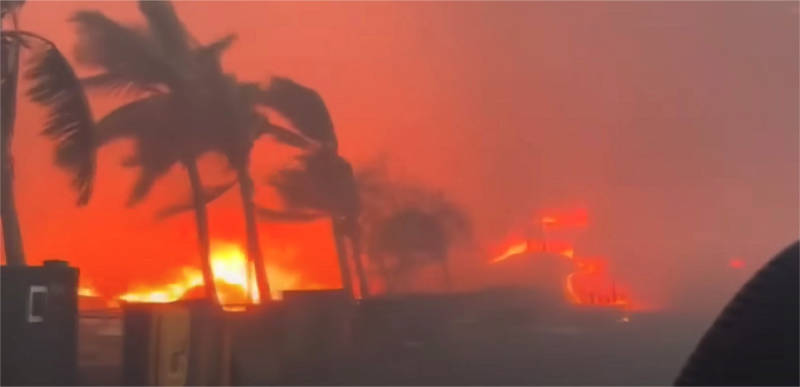New data and video has revealed the origin of the Hawaii wildfires that left untold damage and at least 111 dead on the island of Maui.
According to reports, dozens of power grid failures caused by whipping winds is what caused the fires to start.
Watch below:
JUST IN – An independent Maui company has unveiled new evidence suggesting that equipment failures in the power grid likely triggered multiple fires.
The data was collected through a network of smart sensors known as Ting, distributed to homeowners by insurers.
These sensors,… pic.twitter.com/WwSrgR5otA
— KanekoaTheGreat (@KanekoaTheGreat) August 18, 2023
Here’s what he wrote in the tweet:
An independent Maui company has unveiled new evidence suggesting that equipment failures in the power grid likely triggered multiple fires. The data was collected through a network of smart sensors known as Ting, distributed to homeowners by insurers. These sensors, designed to spot electrical hazards at homes, also detect grid-wide issues in real time.
For example, on August 7th at 10:47 p.m., an explosion occurred near Maui Bird Conservation Center in Upcountry Maui. Soon after, flames appeared along the tree line. Ting’s data analysis showed that ten nearby sensors recorded a sudden voltage drop at that exact time—an unmistakable sign of a grid fault.
Such faults involve abnormal electric currents due to equipment failures, like transformer explosions, fallen power lines, or line contact. These faults, seen in the bird sanctuary explosion video, can cause sparks or arcs, potentially releasing molten metal fragments. Within the same period, 78 sensors across the island identified 122 grid faults, mainly due to strong winds. In West Maui, data indicated significant grid stress. Lahaina saw 34 faults between late evening and early morning, increasing in frequency and intensity.
Meanwhile, Ting data aligned with a Lahaina power outage. During the outage, a local resident recorded a downed power line near his home, sparked by strong winds igniting dry grass. Concerning the fatal fire that destroyed Lahaina town, indications suggest power grid issues played a role. CEO Bob Marshall, who installed Ting sensors across Maui, explained that any of the noted faults could have triggered fires, underscoring the likelihood of power grid problems as a major contributing factor.
In addition to this it turns out that Climate Change was the cause of the wildfires, but not like the left would want to admit.
According to the Wall St Journal, “Four years ago, the utility said it needed to do more to prevent its power lines from emitting sparks. It made little progress, focusing on a shift to clean energy.”
During the 2019 wildfire season, one of the worst Maui had ever seen, Hawaiian Electric concluded that it needed to do far more to prevent its power lines from emitting sparks.
The utility examined California’s plans to reduce fires ignited by power lines, started flying drones over its territory and vowed to take steps to protect its equipment and its customers from the threat of fire.
Nearly four years later, the company has completed little such work. Between 2019 and 2022, it invested less than $245,000 on wildfire-specific projects on the island, regulatory filings show. It didn’t seek state approval to raise rates to pay for broad wildfire-safety improvements until 2022, and has yet to receive it.
Hawaiian Electric has made reference in regulatory filings to the risks of power-line fires, but it waited years to take significant action, documents and interviews show. During that period, the company was undertaking a state-mandated shift to renewable energy.
The growing risk of wildfire on Maui had been known for years. The number of acres burned on the island soared to 39,000 in 2019, from 150 in 1999, according to data compiled by the Hawaii Wildfire Management Organization, a nonprofit that works with government agencies and the public.
At the end of 2019, Hawaiian Electric issued a press release about wildfire risk. It said it would install heavier, insulated conductors on Maui and Oahu to minimize the risk of sparks when winds picked up, as well as technology to detect disruptions when the conductors came into contact with vegetation or each other. It said it would apply fire retardant on poles in risky areas and consider installing cameras and other devices to monitor weather conditions during fire season.
In filings over the next two years with the Hawaii Public Utilities Commission, which is tasked with approving utility projects and spending, the company made only passing reference to wildfire mitigation.
“In 2015, lawmakers passed legislation mandating that the state derive 100% of its electricity from renewable sources by 2045…”
Former regulators and energy company officials said the utility was focused at that time on procuring renewable energy. Hawaii has been on a push to convert to renewables since 2008, when a run-up in oil prices sent electrical rates at Hawaiian Electric—which relied on petroleum imports for 80% of its energy supply—through the roof. In 2015, lawmakers passed legislation mandating that the state derive 100% of its electricity from renewable sources by 2045, the first such requirement in the U.S.
The company dove into reaching the goals, stating in 2017 that it would reach the benchmark five years ahead of schedule.
At least 110 people are dead because lawmakers decided clean energy should be mandated, which led Hawaii Electric to invest heavily to try and comply with the law and ignore the actual wildfire risk.
This is a real life consequence of leftism.

